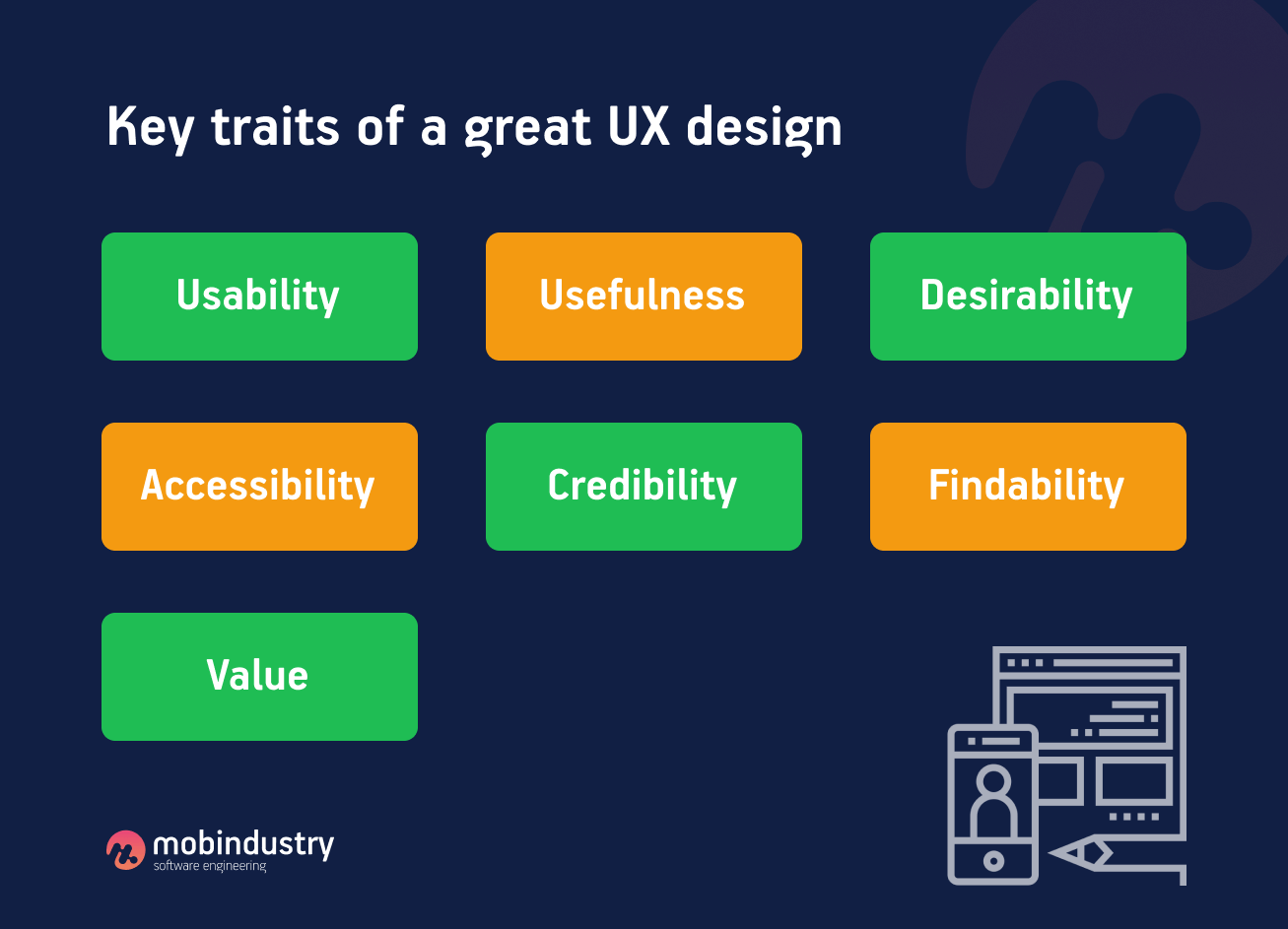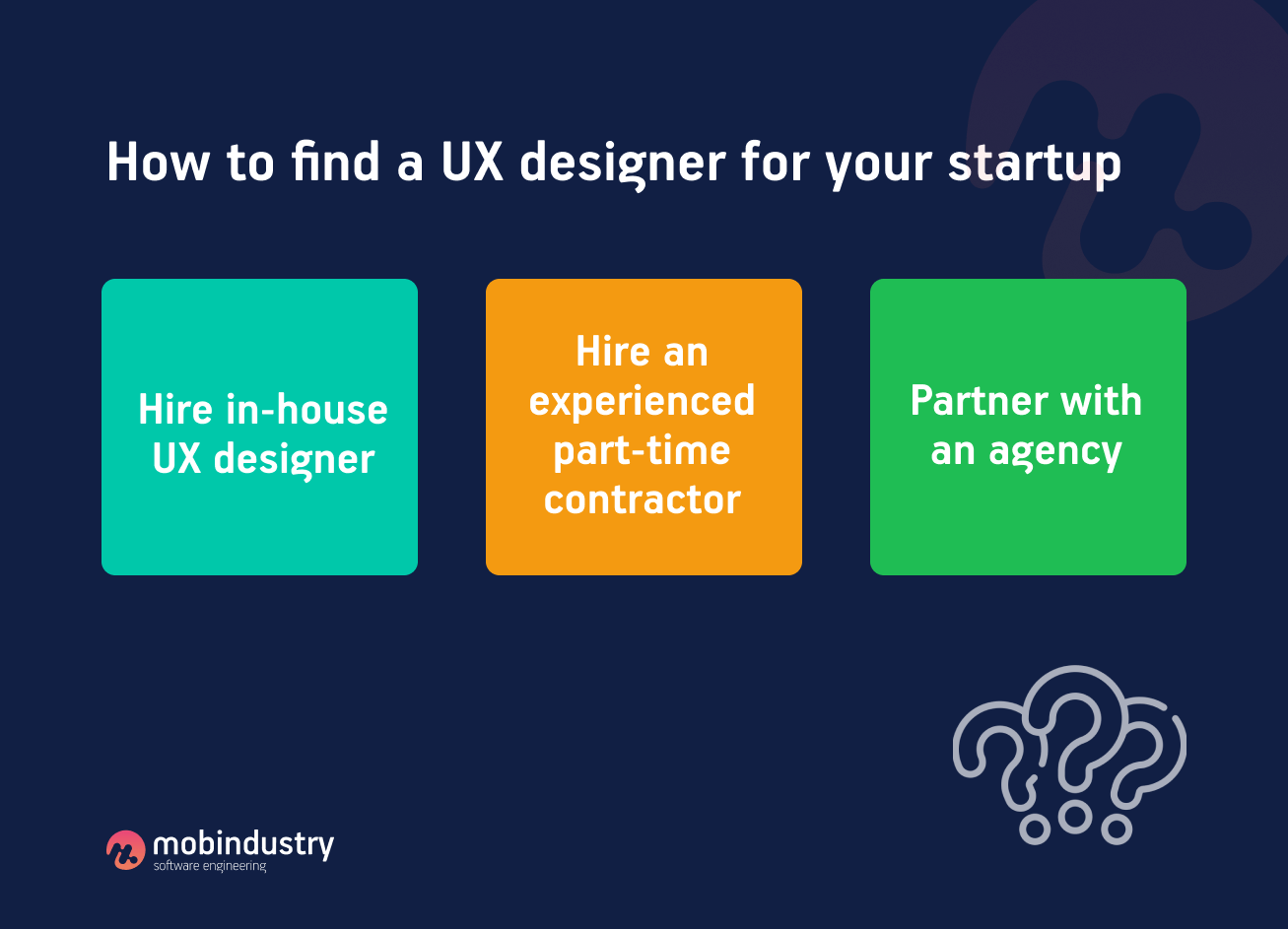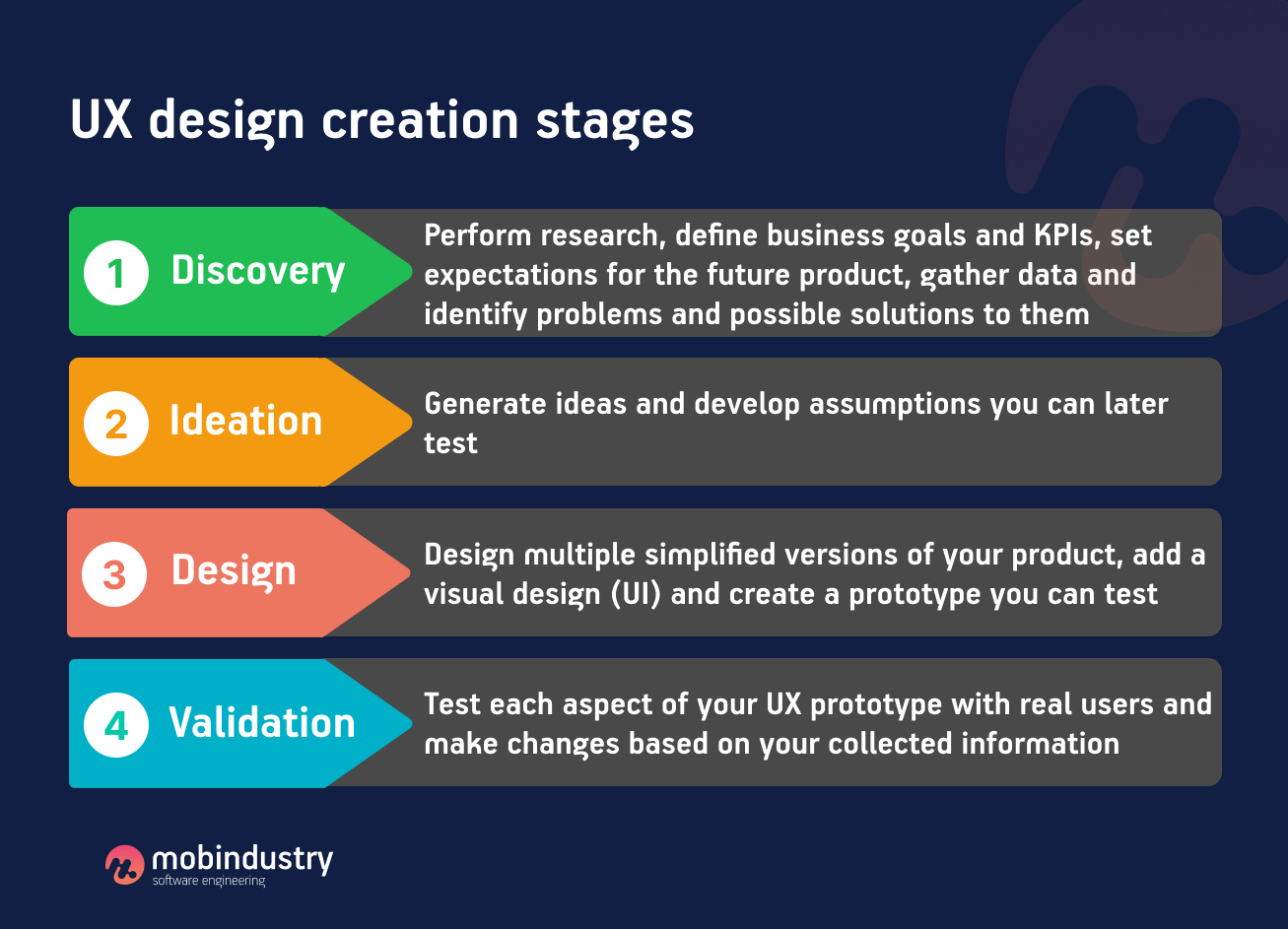UX Design Guide for Startup Owners: Essentials You Need to Know
Great user experience design is one of the cornerstones of product success. As a startup founder, learn how to build your product with a UX mindset and let your vision shine through your product design.
We at Mobindustry have led multiple startups, from ideas to fully-fledged products. We worked with startup founders and owners and helped them gain expertise in user experience.
If you’ve never had experience with UX, don’t worry — you have it in you. Most of the UX strategy development involves a product mindset, and you already have it as a startup owner.
Startup owners already have a UX mindset due to their business-oriented outlook and knowledge about their target market and audience
The other component of a successful user experience design strategy is having processes and best practices in place. This is where we got your back. Our team complements the product outlook of our clients by asking the right questions and providing time-proven processes for building efficient UX.
In this article, you, as a startup owner, will get a better understanding of the user experience, its importance, and the ways to implement it in your project.
What is User Experience design?
User experience (UX) is how your user perceives and interacts with your product to achieve a certain goal. UX design is how you lead your user through their journey from start to finish.
The main goal of UX design is to make the experience of using a product as smooth and efficient as possible. Any hurdles in this journey will make users look for alternatives and may result in lower conversion rates, user satisfaction, and, eventually, lower revenue.
A good user experience design for startups, on the other hand, can turn into increased profit through engagement, satisfaction, brand loyalty, and other positive things about your user’s experience during the interaction.
What makes the user experience great?
What a good user experience looks like? What are the pillars of UX that make your clients want more? One of the most well-known informational architects in the world, Peter Morville, states that a UX for startups should have these characteristics to be deemed effective:
- Usability — your product should be easy to use. Its intuitive interface should lead a user to their goal effortlessly
- Usefulness — each function in your product should be useful and correspond to a business goal and a user need
- Desirability — your product should be pleasant to use and show that it’s tailored specifically for its intended audience
- Accessibility — people with disabilities should be able to use your product, just like most users
- Credibility — your product should be trustworthy. You can achieve this by showing results and encouraging reviews
- Findability — your product should be easy to navigate, and users need to intuitively know where they can find a certain feature or information
- Value — your product should simply be useful for your users and bring them real value
As you can see, there’s many aspects to keep in mind when creating your UX design. How can you do this as a startup owner? Start with building a UX strategy.

What is a UX strategy?
Although UX focuses on users and their perspectives, their interaction with your product should directly lead to your business’s success. A UX strategy ties everything together: your business goals, your team’s vision, intended functionality, technical implementations of your ideas, and your users’ needs.
A UX strategy is a process of generating, testing and implementing UX hypotheses based on your business goals, team’s vision, technical implementations and user needs
A user experience design strategy is usually created at the initial stage of mobile or web development. We at Mobindustry help you build it during the discovery phase, where we extract the business needs and goals from the startup owner, make their idea more definite and work from there toward a user journey.
As a startup owner, how do you build a UX strategy and, eventually, a UX design for a successful product? You need to hire the right UX designer who can dive into your business and combine your vision and industry expertise with UX practices.
How to find a UX designer for your startup
As a startup founder, you need to strike a balance between speed and cost. How do you find UX specialists with limited funds and time? Let’s look at all the options.

Hiring an in-house UX designer
This option is hardly ideal for most startups unless your funding is sufficient to sustain the development process that lasts over one year and the product is planned huge from the get-go.
An in-house user experience designer requires a constant flow of tasks, and the hiring process is also time-consuming and costly.
However, some startup owners that value having an in-house team choose to hire a junior UX designer and train them inside the company. It’s a more cost-effective option but requires more effort and attention. An inexperienced designer without proper training can do more harm than good, especially in the long run.
So, what are the best ways for a startup to hire UX specialists to implement UX processes and tools aligned with your vision, pacing, business goals, and team? There are two options.
Hire an experienced part-time contractor
An accomplished UX designer with experience building UX design for startups from scratch is a wonderful option for startups. They can work efficiently, so you can hire them part-time without sacrificing your work pacing.
Your contractor should have a solid portfolio, references, and a proven track record of helping businesses build the best user experience design possible.
Setting expectations for both parties early is very important when hiring a contractor. Invest time in writing a thorough job description that will impress a seasoned professional, so they’re glad to take up the challenge. Ask your business partners, acquaintances, and former colleagues to refer someone they trust.
Partner with an agency
An agency can be a great place to find seasoned UX designers who are integrated into the full product development lifecycle, and are constantly working on different projects. They often have experience in many domains, which helps them come up with creative solutions for problems.
Most agencies will offer you multiple collaboration models: fixed price or time and materials, dedicated or outstaff. You can hire a UX specialist for any time and frequency, and you’re not tied to a work contract.
By partnering with an agency, you can always expand your team and get additional specialists like business analysts, project managers, product managers, and developers. It’s like getting a full in-house team of dedicated, experienced specialists.
Partnering with an agency may seem more expensive than hiring in-house. And this may be true if you choose a local agency in the US or Western Europe. However, remote collaboration is increasingly popular in the current landscape, so you can partner with any agency worldwide.
With an agency, you can skip the lengthy and costly hiring process and other expenses like taxes, bonuses, sick leaves, workspace, equipment, etc. Moreover, when hiring an agency from a country like Ukraine, you can save up to 60% of your budget just because of the rate difference.
How to build UX expertise in your startup team
Regardless of how you found your first UX designer and how exactly you collaborate, it’s important for you as a startup founder to understand the UX principles, get into the user experience mindset, and get familiar with the main UX tools.

Modern UX design is user-centric, based on research and iterations, and focused on real-world outcomes. This naturally leads to a certain process of creating UX design that consists of these stages:
- Discovery — at this stage, you and your term perform research, define business goals and KPIs, set expectations for the future product, gather data and identify problems and possible solutions to them.
- Ideation — now it’s time to generate ideas and develop assumptions you can later test
- Design — this is where you design multiple simplified versions of your product or a separate feature that aligns with your main concept. At this stage, you can also add a visual design (UI) and create a prototype you can test.
- Validation — now it’s time to test each aspect of your UX prototype with real users and make changes based on your collected information.
This cycle will happen each time you develop a new feature for your product, so UX design isn’t something that only happens at the start of the project. Every time you want to make significant changes to your product or develop something new, you’ll need to come up with hypotheses, do research, design several versions and then test it with a small group of your audience.
You need a structured set of UX tools to efficiently facilitate this process. Ask your user experience designer to put together a virtual toolkit for your company. This will allow you and your team to learn when and how to use the tools.
This UX toolkit should include:
- Checklists
- Best practices
- Recommendations
- Scripts
- Resources
- Links to digital tools (e.g. Figma)
The responsibilities of a UX designer include facilitating the whole design process, from research to testing. However, you as a startup owner also need to take part in all processes and gain UX expertise.
How Mobindustry can help your startup with UX design
At Mobindustry, we’ve helped multiple entrepreneurs to build products from scratch. They came to us with an idea for a digital product to enhance their business. Usually, we started exactly with a user experience design and strategy.
If our client didn’t have an in-house development team and didn’t want to bother managing separate contractors, they could always stay with us for development too. Others hired just one or two specialists from us to scale their existing teams quickly. As you can see, the possibilities for collaboration are endless.
But let’s stop at UX design services for now. What do they look like at Mobindustry?
Step 1. Initial interview
Once you contact us, we will set up an appointment and get to know each other better. At this stage, you share your business idea, and we provide you with a rough estimate of how much a product of this type can cost.
Step 2. Discovery phase
At this stage, we delve into your business needs deeper, perform market research, competitor analysis, and UX research, and develop a UX draft in close collaboration with you. We mix your industry knowledge with the best practices of UX design and suggest our own solutions based on our experience.
Step 3. Software requirement documentation and UX design
Now, we refine your ideas by putting together a feature list and expressing it in a fully-fledged UX design prototype. We make a demo for you and test it with stakeholders and/or a focus group.
After that, we usually suggest creating an MVP, as it allows you to release your product fast and at a lower cost and immediately start UX and usability testing in the real world with real users.
After getting feedback from real users, we can refine the UX further and bring your product to its best form, tailored for the market and your target audience.
Then, we build the functionality and create a user interface design on top of the UX, turning a concept into a working product.
Final thoughts
As a founder of a startup, you need to wear a lot of hats. UX is one of them, and it takes place among the top most important ones. The UX mindset is already within you, everything you need is a set of tools and a specialist who can guide you through the process of building design.
We at Mobindustry are proud to help startups make their ideas crystal clear and translate them into usable and effective solutions. If you’d like to discuss your idea with us and get professional UX guidance, make sure to contact us!

